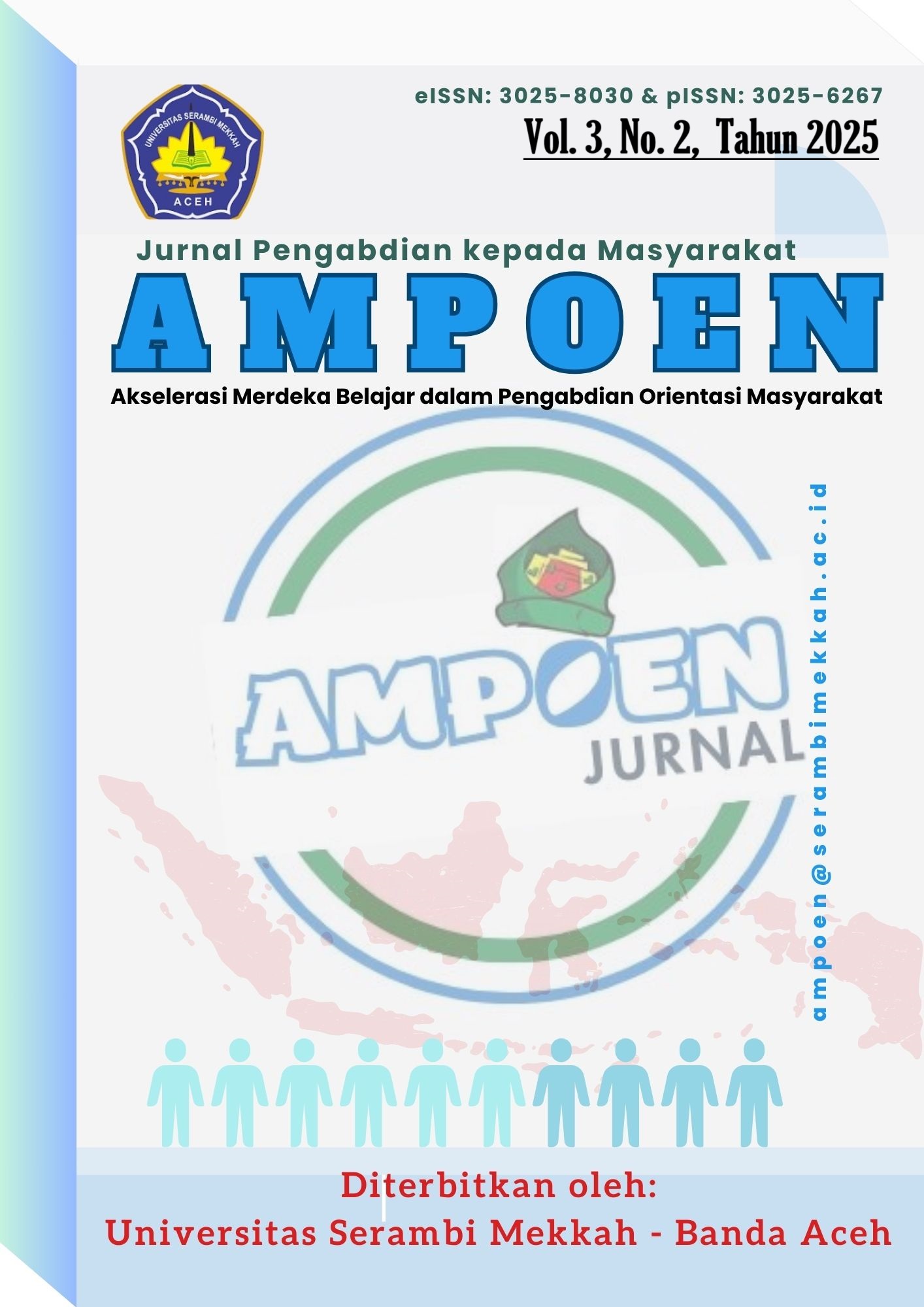HIMARS MENGAJAR CUCI TANGAN MENUJU KESEHATAN YANG HEBAT
Main Article Content
Abstract
he community service activity themed “Handwashing Towards Great Health” was conducted at SDN Grantung on April 19, 2025, as an effort to promote health and encourage clean living behavior among elementary school students. This activity was motivated by the importance of handwashing as a preventive measure against infectious diseases, while many students still lacked knowledge of proper handwashing techniques. The methods included preparation and coordination, interactive health education, demonstration of the six steps of proper handwashing according to WHO standards, interactive quizzes, and evaluation through pre-test and post-test. The results showed a significant improvement in students’ knowledge and skills. Before the intervention, only a few students understood the correct handwashing steps, while after the program, the majority were able to explain and practice them accurately. The conclusion highlights that interactive and practice-based education methods are effective in improving students’ understanding and can foster sustainable healthy habits. Future recommendations include continuous teacher supervision and the provision of adequate handwashing facilities to ensure the long-term adoption of this behavior.
Article Details

This work is licensed under a Creative Commons Attribution-ShareAlike 4.0 International License.
References
Al Nadwi, H. H., Alzahrani, A. H., Kalo, B. B., Alhajaji, R., & Bari, O. (2022). The Effects of Handwashing Education on Knowledge and Practice Among Primary School Children in Makkah City. European Journal of Preventive Medicine, 10(1), 48–57. https://doi.org/10.11648/j.ejpm.20221001.19
Atshan, R. S. (2024). Effectiveness of Intervention Program on Primary School Pupils’ about Hand-washing Practices. Academia Open, 9(1). https://doi.org/10.21070/acopen.9.2024.8683
Berhanu, A., Mengistu, D. A., Temesgen, L. M., Mulat, S., Dirirsa, G., & Alemu, F. K. (2022). Hand washing practice among public primary school children and associated factors in Harar town, eastern Ethiopia: An institution-based cross-sectional study. Frontiers in Public Health, 10. https://doi.org/10.3389/fpubh.2022.975507
Dreibelbis, R., Kroeger, A., Hossain, K., Venkatesh, M., & Ram, P. (2016). Behavior change without behavior change communication: nudging handwashing among primary school students in Bangladesh. International Journal of Environmental Research and Public Health, 13(1), 129. https://doi.org/10.3390/ijerph13010129
Freeman, M. C., Clasen, T., Dreibelbis, R., Saboori, S., Greene, L. E., Brumback, B., & Rheingans, R. (2014). The impact of a school-based water supply and treatment, hygiene, and sanitation programme on pupil diarrhoea: a cluster-randomized trial. Epidemiology & Infection, 142(2), 340–351. https://doi.org/10.1017/S0950268813003112
Grover, E., Hossain, M. K., Uddin, S., Venkatesh, M., & Ram, P. K. (2018). Comparing the behavioural impact of a nudge-based handwashing intervention to high-intensity hygiene education: a cluster-randomised trial in rural Bangladesh. Tropical Medicine & International Health, 23(1), 10–25. https://doi.org/10.1111/tmi.12999
Marantika, A., & Dwihestie, L. (2020). The Effect of Health Counseling on Handwashing Technique in Primary Schools. Indonesian Journal of Global Health Research, 2(3), 217-224. https://doi.org/10.37287/ijghr.v2i3.172
Naluonde, T., Wakefield, C., Markle, L., Martin, A., Tresphor, C., Abdullah, R., & Larsen, D. (2019). A disruptive cue improves handwashing in school children in Zambia. Health Promotion International, 34(6), e119-e128. https://doi.org/10.1093/heapro/day027
Pasewaldt, S. E., Baller, S. L., Blackstone, S. R., & Malenke, L. B. (2019). Impact of a Hand Hygiene Curriculum and Group Handwashing Station at Two Primary Schools in East Africa. Journal of Humanitarian Affairs. https://doi.org/10.1177/0272684X18819968
Wichaidit, W., Steinacher, R., Okal, J. A., Whinnery, J., Null, C., Kordas, K., & Ram, P. K. (2019). Effect of an equipment-behavior change intervention on handwashing behavior among primary school children in Kenya: the Povu Poa school pilot study. BMC Public Health, 19(1), 647. https://doi.org/10.1186/s12889-019-6902-2
Tambahan:
Anyango, M. J. (2019). Water, Sanitation and Hygiene Practices as Predictors of Diarrhoea Occurrence among School Age Children in Ganze Sub County, Kenya. [Doctoral dissertation, Jomo Kenyatta University of Agriculture and Technology]. http://ir.jkuat.ac.ke/handle/123456789/4759
Biran, A., Schmidt, W., Varadharajan, K. S., Rajaraman, D., Kumar, R., Greenland, K., & Curtis, V. (2014). Effect of a behaviour-change intervention on handwashing with soap in India (SuperAmma): a cluster-randomised trial. The Lancet Global Health, 2(3), e145-e154. https://doi.org/10.1016/S2214-109X(13)70160-8
Chittleborough, C. R., Nicholson, A. L., Basker, E., Bell, S., & Campbell, R. (2012). Factors influencing hand washing behaviour in primary schools: process evaluation within a randomized controlled trial. Health Education Research, 27(6), 1055-1068. https://doi.org/10.1093/her/cys061
Lopez-Quintero, C., Freeman, P., & Neumark, Y. (2009). Hand washing among school children in Bogota, Colombia. American Journal of Public Health, 99(1), 94-101. https://doi.org/10.2105/AJPH.2007.129759
Rabbi, S. E., & Dey, N. C. (2013). Exploratory study on factors influencing hygiene behaviour among school children in Dhaka, Bangladesh. BMC Public Health, 13, 20. https://doi.org/10.1186/1471-2458-13-20
